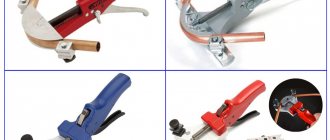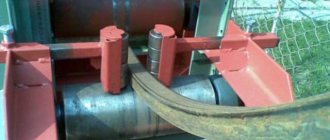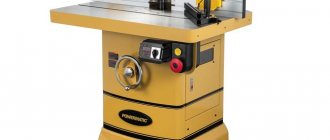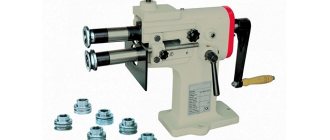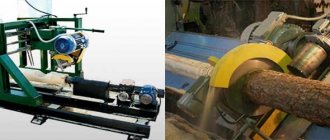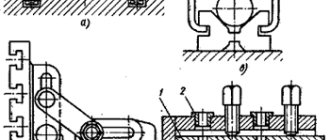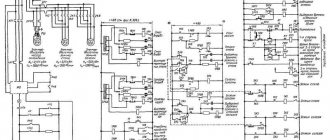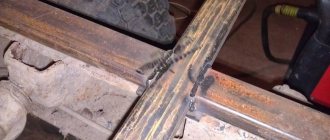Good time! I started this whole thing somewhere in July. At the beginning there are drawings. Selection of material. Lathes, etc. There are almost no photos left - they are lost))) The machine was made for my own needs. I focused on the 15th professional pipe. In terms of finance, about 4,000 thousand rubles. The rest of the material was found on the farm. Everything is clear in the video. I won’t bother you with writings))) Well, a couple of photos.
LET'S SUBSCRIBE! Let's share! Let's comment!
Forgot to add photos)) The result of the work. More about the machine later.
Rollers for profile pipes are a tool that not everyone knows. What is it and what is it needed for?
Machine for strengthening profile pipes
Reinforcement means the formation of ribs at the corners of a square or rectangular profile during rolling on specially shaped rollers.
Pipes with a reinforced profile are characterized by high bending strength and are used to create curved structures of any degree of complexity.
The profile is strengthened using specialized equipment.
Application area
To obtain the desired configuration, profile pipes are sequentially processed on profile strengthening machines, a forging block and a pipe bender.
A pipe bender allows you to bend profile pipes along a longitudinal section along a given radius. Such products are used when installing canopies, gazebos, and canopies.
Reinforcement is a necessary stage in preparing a profile pipe for making a curl using the cold forging method. The forging block allows you to create decorative elements from pipes with a square or rectangular cross-section, curved in the most bizarre way. The resulting products are distinguished by their volume, lightness, and low price.
Design
The machine for strengthening the profile is in many respects similar in principle of operation and design to a conventional rolling machine.
In addition to the frame and the motion drive, the main components of the machine for reinforcing a profile pipe are:
- Lower (support) shaft – 1 pc. It is leading, with its help the pipes move.
- The upper shaft is a pressure shaft. Deforms the profile - presses the pipe against the lower shaft.
The supply and receiving shafts are securely mounted on a massive base (housing); it must ensure the stability of the installation during operation. The feed mechanism ensures the rotation of the shafts around its axis.
Process technology
The amplification process on the simplest machine is performed sequentially, with two pipe installations:
- Step 1 – installing the pipe on the rollers.
- Step 2 – rolling the first 2 symmetrical sides.
- 3rd step - reinstallation of the pipe (rotate 90 0).
- Stage 4 - rental of the second 2 symmetrical sides of the profile.
Machine for profile reinforcement
Profile reinforcement is performed on a cold forging machine equipped with rollers for compressing the profile pipe before bending it into a curl.
Profile pipe
The rolling process depends on the wall thickness of the profile pipes and the grade of material from which they are made
Drive mechanism
According to the principle of operation, there are different types of wire mechanisms:
The manually driven machine has a simple design, compactness, and is designed for small volumes of work. Only a physically developed person can work on it. The metal will have to be deformed using muscle force.
An electrically driven machine for strengthening a profile pipe also does not take up much space. It is powered by an electric motor and has high performance.
Hydraulically driven equipment is too bulky. Allows you to roll profile products with maximum dimensions. Designed for large volumes of work.
Functionality
Multifunctional stationary modules, which are equipped with:
- rollers to strengthen the profile pipe;
- rollers for rolling out the ends of blanks in the form of artistic elements;
- forging block for cold forging.
All operations are performed without readjusting equipment or changing tools. The modules make it possible to produce various decorative forged elements of different sizes and required shapes.
An example of a multi-purpose installation is a reinforcement unit with rolling crow's feet (PGL), produced commercially, adapted for several operations:
- “crow’s feet” type reinforcement (squeezing, squeezing);
- rolling out the ends of the workpiece.
After this treatment, the pipe is completely ready for making a decorative curl on a forging block.
Making a machine yourself
It doesn't always make sense to purchase a professional machine. For one-time work, simple DIY installations are more suitable. The main thing is to have drawings, carefully study the design principle and operation of the machine, select high-quality materials for the workpieces and the necessary tools for assembly.
Scheme
Schematic diagram of a machine for rolling 2 types of profile sections in section. Based on it, you can get an idea of the design and interconnection of the main components and the principle of pipe processing. In this case, the upper shaft is the driving one.
Machine diagram
Accessories
Rolling roller components must not have chips or gouges, have a decent margin of safety, and be made from certain grades of steel.
Shafts and axles are turned on a lathe. Some components can be bought in a store or removed from other mechanisms, for example:
- self-aligning rolling bearings (4 pcs.);
- stars (4 pcs.);
- chain from a bicycle, moped.
To assemble the frame (base), you will need rolled metal (channels, pipes), sheets 5-10 mm thick. The base ensures stability of the installation during operation.
Frame assembly
To strengthen the profile, it is better to make rollers (2 pieces of each type) from alloy steel; for a small amount of work, St3, St10 are also suitable. Roll blanks are subjected to hardening.
Rollers and axles must be many times harder than the pipes being processed. Otherwise, the rollers will have to be replaced frequently with new ones. The hardness of rollers on professional installations is at least 52 HRC.
Tools
When assembling the machine, you will need the following skills (as well as appropriate equipment):
Fastening by welding in some places can be replaced with threaded connections.
- drill, with a set of drills;
- wrenches of different sizes;
- level for setting the horizon line;
- caliper, tape measure.
Design of incoming parts
Special rollers are machined along the edges of the rollers, which reliably fix the position of the pipe during rolling.
Rollers
You can get the dimensions of the rollers for profile drawing from a kit from professional installations. It is not difficult to develop drawings of rollers and axles according to the obtained dimensions yourself. Below is an example drawing.
Roller drawing
Rolling of each profile size is carried out using rollers of appropriate sizes. Making a model with removable elements is not easy; for this reason, it is recommended to make multi-stage rollers for reinforcing the profile pipe when assembling the machine yourself. This will allow processing of pipes of different sizes without reinstalling the rollers.
Both axes have the same dimensions, but different lengths. The movement handle is attached to the longer axis (driving). Below is a drawing of an axle with a seat for the handle.
Drawing of an axle with a seat for the handle
Assembly work
The frame is created gradually as the remaining parts are assembled. The individual elements of the base are connected to each other by welding or large bolts.
The distance between the upper and lower axle depends on the diameters of the rollers. In the absence of precise assembly drawings, the dimensions between the axes are determined experimentally:
- install the rollers on the axle;
- measure the distance between the axes;
- drill holes on the side walls of the frame for installing bearings;
- then the axles are put aside and the bearings are installed.
The connection between the axle and the rollers is carried out in several ways:
- using a key, about 8x8 mm in size;
- welding through pre-drilled countersunk blind holes made with a large-diameter drill.
The second method is available if you have a machine for manual electric arc or semi-automatic welding.
Next, the axle is inserted into the bearing, which is pre-fixed in the axle box, which is pre-welded to the wall of the frame from the inside. Reliability of fastening is maximum. First of all, the axles with rollers are installed in the side wall of the frame where the chain drive is supposed to be located. Then the axles are inserted into bearings mounted on the 2nd side wall of the frame.
After installing the main elements, the frame is strengthened:
- welding seams;
- threaded connections.
DIY assembly
Pipe bending rollers are a simple device. You can even make it from scrap materials left over after renovation and construction. In most cases, when deciding how to make rollers, novice craftsmen tend to choose a mechanical type design. It is easy to design and assemble using welding, which is found in every home.
The small-sized machine is easy to move around the site; there is no need to build a separate room for it.
Drawing
Before making a high-quality and functional machine for bending profiles, it is necessary to make detailed drawings, the dimensions of all parts should be applied with high accuracy.
Roll patterns can be made on graph paper or on a computer. The choice depends on design skills. Based on the drawn up drawings, the need for building materials and tools is calculated. An estimate is made, equipment is selected and missing property is purchased.
Materials and tools
To assemble homemade rollers, you will need the following tools and consumables:
- welding machine;
- grinder or milling cutter with discs for metal;
- roulette;
- electric drill;
- set of screwdrivers and wrenches;
- square;
- core;
- oil level;
- hardware (angles, bolts, nuts, rivets);
- channel or I-beam;
- blanks for shafts;
- profile pipes.
When selecting material for construction, you should remember that metals and alloys for rollers must be much stronger than the steel of profile pipes.
What is included in the design
The bed is made of thick and heavy rolled steel.
The strength and weight of the base must correspond to the force applied when rolling the profiles. The assembled frame must be stable and strong so as not to swing during operation.
The clamping system is assembled in the shape of the letter “P”. A threaded hole is made on the top crossbar to create clamping force. Another option is to weld the nut over the round hole. Subsequently, a bolt is inserted into it to adjust the clearance between the rollers.
The rollers themselves are equipped with rolling bearings, which are mounted on durable axles. The rollers are turned on a lathe and undergo a hardening cycle in oil.
The drive is made from bicycle sprockets and a chain. The sprockets are welded to the driven and drive shafts, and then connected by a chain. A gate with sufficient leverage is welded onto the drive sprocket.
Filling with sand or water?
When the workpieces are given a strong bend, they are flattened and the cross-section geometry is disrupted. In order to prevent this, hollow profiles are filled with dense material that does not change volume under pressure.
The simplest solution is to fill the blanks with sand. It is spilled with water, compacted, and then plugs are welded to the ends.
With water it is more difficult, since the plugs must be sealed. If the assembly takes place in winter, then the best solution would be to fill the pipes with water, cover them with plastic plugs and freeze them. This method is used in the manufacture of wind musical instruments.
Spring selection
Springs are used to reduce the impact of vibration from the electric motor on the rolling system. With strong vibration, workpieces may shift along the horizontal axis. The springs must be stiff to prevent the engine from rocking and at the same time reduce shaking. It is recommended to use at least 4 springs to fix the motor frame.
Cut and cook
The roller manufacturing process is carried out in the following sequence:
- Taking measurements and applying markings in accordance with the diagrams.
- Cutting rolled products into blanks, cleaning the field for welding.
- Turning and hardening of shafts, installing bearings in them, attaching sprockets, securing them to an axle.
- Welding the frame with a rolling and pressing mechanism.
- Drive installation. It can be permanent or removable.
- Checking the functionality of the machine.
Finally, the metal is cleaned from rust, primed and painted. Moving parts are lubricated.
Recommendations
Special requirements are placed on the alignment of the rollers: they must be located in the same vertical plane and be strictly parallel. Any misalignment will lead to uneven compression of the profile, which will significantly reduce the quality of the rolled product.
A machine made at home specifically for strengthening profile pipes should not pose a danger to humans during operation. During assembly you should:
- Fix all moving parts as reliably as possible. Prevent them from bouncing during operation.
- Provide protective flaps.
Properly assembled home-made installations are not inferior to professional models in terms of the quality of their products.
Rollers for profile pipes: making manual profile bending with your own hands
Making rollers for a profile pipe with your own hands, using drawings and knowledge of the operating principle of this useful device, is quite possible. Using such a device, which is highly versatile, you can independently produce bent structures of any degree of complexity from corrugated pipes.
Rolling profile pipes for a canopy on a homemade machine
The main working parts of the rollers, which exert a mechanical effect on the processed profile pipe, are rotating rollers, the number of which can vary from 3 to 5 pieces. It is in the gap between the rolls that plastic deformation of the corrugated pipe occurs.
Details about rolling
You can make the pipe take a different shape using a simple torch. This approach is often practiced, but the employee faces a number of difficulties:
- there is a need for a large lever to change the shape;
- you need emphasis and, as a result, a lot of physical strength;
- It is almost impossible to make the product even; this is due to inaccurate movements and improper distribution of effort.
Manual profile bender
To get the best result, you should use rollers. With their help, a profile pipe can be easily transformed with your own hands. The photos and videos show the features of working with the tool. To familiarize yourself with the result of the tool's work, drawings are presented.
1 Type of machine is designed for radius bending of profile pipes.
Standard machine characteristics:
The maximum pipe cross-section is 40 x 40 x 2, 50 x 25 x 2 mm.
Minimum circle diameters:
- 20x20x2, 25x25x2, 15x15x1.5 –560 mm
- 30x30x2 - 650 mm,
- 40x20x2 - 650 mm,
- 40x40x2 - 1800 mm,
- 50x25x2 - 800 mm.
The maximum arc diameter is unlimited.
Drive type: manual.
Hardened rollers – all 3 pcs.
Price: 25,000 rubles.
2 Type of machine is designed for radius bending of profile pipes, round pipes and strips.
Characteristics of the universal machine:
The maximum pipe cross-section is 40x40x2, 50x25x2 mm.
The maximum cross-section of a round pipe is 32x2.8 mm.
Strip 40x4 mm.
Minimum diameters of a circle of profile pipes:
- 20x20x2, 25x25x2, 15x15x1.5 –560 mm
- 30x30x2 - 650 mm,
- 40x20x2 - 650 mm,
- 40x40x2 - 1800 mm,
- 50x25x2 - 800 mm.
The maximum arc diameter is unlimited.
Drive type: manual.
Hardened rollers – all 3 pcs.
Price: 30,000 rubles.
At the Customer's request, for an additional fee, the machine is equipped with a dial indicator for the production of more accurate all subsequent workpieces.
For an additional fee, the machine can be equipped with a 220-380V electric drive
2 year warranty
Contacts:
Tel: 8-919-831-25-14
Saratov region Engels
Delivery within the Russian Federation.
Types of devices with rotating rollers
Rolling of a profile pipe, which results in a change in its original configuration, can be performed on equipment of various designs. Such devices for rolling profile pipes can differ according to the type of drive used and the main technical characteristics. Thus, rolling rollers can have:
- manual drive (the use of such devices for rolling profile pipes requires significant physical effort);
- electric drive;
- hydraulic drive mechanism.
Manual rolling rollers serve as a prototype for self-manufacturing of the machine
The simplest (and, accordingly, inexpensive) devices used to roll a profile pipe are manual profile benders. Along with their reliability and ease of use, they are distinguished by a number of significant advantages. The design of a manual profile bender consists of the following elements:
- a massive frame that serves as a reliable foundation for the entire structure;
- rollers that perform feeding and receiving functions (these structural elements, with the help of which rolling is performed, are connected to each other via a chain transmission);
- a set of clamping mechanisms (clamps) designed for fixing pipes of various sizes.
Main parts of rollers
This rolling machine, which has a simple design, is also equipped with a special pipe, which acts as a guide for the bent workpiece. It should be borne in mind that using such a machine requires the performer to exert significant physical effort. In addition, this device does not allow rolling with high productivity and is most often used for simple work at home. That is why the design diagram of this machine is used to make a profile bending machine with your own hands. Such a simple design profile bender allows you to perform rolling of profile pipes with high quality and high efficiency.
An electric machine for rolling profile pipes, even one made independently, provides higher productivity of the technological operation. This is explained by the fact that an electric drive, the power of which can be quite large, is responsible for performing the main operation - pulling the professional pipe through the rollers. That is why electric rollers for profile pipes, which you can make yourself using drawings, are used both by small organizations or home craftsmen, and by manufacturing enterprises.
The machine can be equipped with an electric drive later, the main thing is to take this into account initially and develop a sufficiently powerful design
However, of course, the hydraulic profile bending machine has the highest power, which is quite difficult to make with your own hands. Devices of this type, intended for rolling profile pipes, are used mainly in industrial enterprises, where it is necessary to carry out such a technological operation with high productivity.
Creating curved surfaces
In load-bearing structures, the profile pipe plays the role of a horizontal, vertical or inclined support for balconies, ceilings or roofs. But for canopies, canopies or greenhouses it is necessary to create a curved surface.
This is explained by several reasons:
- Aesthetic perception . Round shapes have a calming effect on vision and the human psyche.
- Wind and precipitation . The streamlined shape does not serve as an obstacle to the wind, so during strong gusts the rounded surface poses virtually no threat. In addition, round shapes do not retain precipitation in the form of rain and snow.
To create a curved surface, you need to bend the material. This action can be performed by heating individual areas with a gas burner.
This is the simplest bending method, but it has some disadvantages:
- Firstly , its implementation requires a large lever, a strong stop of the tubular product and enormous physical effort.
- Secondly , it is impossible to achieve uniform bending in this way.
You can create an even sector of a circle using rollers.
Homemade devices for rolling pipes
It is practically impossible to do without such a device as a device for rolling corrugated pipes in those situations when you decide to do your own repairs, during which you will have to deal with bent pipes. To do this, you can purchase a serial device for this purpose or use a homemade profile bender, the design of which is not very complex. It also makes sense to ask the question of how to make a profile bender for the reason that serial models are quite expensive, so purchasing them (especially if they are required only for home repairs) is not always advisable.
Approximate dimensions of homemade rollers
In order to make high-quality homemade rollers, you can study theoretical information, watch a video on this topic, but the main thing is to follow the recommendations of those who have already achieved good results in solving this issue. Of course, to make your own roller, you need to have not only the appropriate knowledge, but also certain skills in the manufacture and use of various technical devices.
Kinematic diagram of the machine
Homemade rollers can even be made from scrap materials, which are almost always available in any garage or home workshop. Moreover, the efficiency of such rollers, if they are made taking into account all the recommendations, will not be much lower than that of commercially produced models.
Machine shaft drawings:
Methods for installing load-bearing structures
When installing load-bearing structures, the joining of elements is carried out in two ways:
- By welding . The connection of elements by welding is strong and durable. This is especially important in places where there is a lot of pressure on the connection.
- Using bolts . This connection is more profitable, since not everyone has a welding machine. Bolts can be used to connect elements of greenhouses, sheds and shelving.
Load-bearing parts on which a large load is planned are best made using I-beams or channels. These elements are not so beautiful, but have high strength compared to a profile pipe.
How to make a profile bender yourself
To make a profile bending machine with your own hands, you need to follow the following sequence of actions.
- First of all, the base or frame is made, for which large-diameter pipes or steel channels can be used.
- Serious attention should be paid to the manufacture of a vertical support for the machine, the material for which can be a U-shaped profile. It is in the upper part of such a support, which must be highly reliable, that a pipe-deforming unit - a roller mechanism - is installed. To mount a vertical support, the lower part of which is securely fixed under the frame, you will need a clamp of the appropriate size. With this method of attaching the vertical support, the deformation force exerted on the bent profile pipe will be evenly distributed over the two feed rollers.
- To drive the feed rollers, a chain drive is used, which can be assembled using a chain and sprockets from an old bicycle. Sprockets, which in their geometric parameters must strictly correspond to the characteristics of the chain used, are fixed on the feed and driven shafts. When installing a chain feed mechanism for your homemade machine, you should ensure good chain tension and only then proceed to fix the feed mechanism handle. Naturally, the drive mechanism of your machine for rolling corrugated pipes should ensure easy rotation of the feed and driven shafts.
- The homemade rollers themselves, which will exert pressure on the bent profile pipe and thereby absorb the main load during operation of the machine, are best made from steel that has undergone a hardening procedure.
In order for a do-it-yourself rolling machine for profile pipes to be highly versatile and can be used for processing products of various sizes, its design must provide for the possibility of radial adjustment. This important option allows you to change the size of the gap between the work rolls. To make your homemade rollers even more functional, you can provide in their design the possibility of making angular or, as it is also called, axial adjustment.
Drawings and instructions for making your own rollers for a profile pipe
The advent of cellular polycarbonate for the manufacture of greenhouses determined a new type of structure for protected ground structures - arched structures. To create a metal frame for such buildings, you need to have a machine capable of bending structural profiles along a certain curve. Homemade rollers for profile pipes are designed to help in the manufacture of arches along a given radius.
The technological process of profiling long workpieces is based on pulling the part through rollers located at a certain distance from each other. To give a bend in one direction or another, the length of the length is not passed in a straight direction, one or two rollers are offset.
Industrial and home rollers
Not all modifications of this amazing tool can be used at home. How do you think a profile pipe is made? Of course, with the help of rollers. This is done as follows. The sheet of metal is rolled into a cylinder and the seam is welded. Next, the pipe is passed through rollers. Under the influence of high pressure, the desired profile is obtained.
Electric profile bender
To do the work, enormous effort is required, so the profile pipe is produced using special equipment. Rollers installed in factories weigh more than ten tons. How can you do this kind of work yourself?
Pipe rolling machine
When rolling long pipes on a machine, the center of movement is shifted. Due to this displacement, a curve is formed between the rollers. One roller presses from the inside of the radial contour, and the other two form the external contour of the future product.
Drawing of a pipe bender for pulling profile pipes. All dimensions of parts required for manufacturing are indicated:
Structurally, such a device is made on a strong support made of channel. The lower rollers are located in bearings. Usually the distance between them does not change (there are versions of the machine where, by changing the location of the lower rollers, a different rolling radius is created).
The top roller is located on top. It can be moved in height. By moving the supporting part downward along the thread, significant forces can be developed. They will act on the pipe during the rolling process.
For self-production, you can go a different route. The walls of the device are cut out of a sheet 2...4 mm thick, where the rollers are installed.
Simplified pipe bender design:
The most difficult thing is to make the sidewalls, inside of which are located:
- Support shafts – 2 pcs.
- A pressure roller located on a suitable device.
- A handle that allows you to roll a profile pipe.
Industrial machines are made with manual or electric drive. When manufacturing an electrified machine, the possibility of reverse must be provided. Then you can roll, forcing the length to move in both directions.
Making a pipe bender with your own hands
The simplest pipe bender is relatively easy to make. Need to purchase:
- bearings No. 206;
- bearing housings;
- shafts Ø 35 mm made of hardened steel HRC 40...45 (suitable for the internal size of the bearings);
- bicycle sprockets of the same diameter;
- bicycle pedal;
- lead screw with nut;
- channel No. 8;
- channel No. 6;
- M8 bolts with nuts;
- strip 40 mm, thickness 4 mm.
To make it you need to use:
- Electric drill.
- File.
- Angle grinder with cutting and cleaning discs.
- Welding machine.
- Set of wrenches.
Step-by-step manufacturing of the machine
Having prepared a set of components, we begin manufacturing.
General view of the machine. It is installed on timber 100·50 mm.
All details are displayed in a visible place. The performance of the bearings and lead screw is preliminarily checked.
Blanks are cut from channels. A vertical stand is welded from them, installed perpendicular to the supporting channel.
A hole is drilled for the lead screw. A nut is welded to it. Then screw in the screw. A cross member is welded on top; it will be needed to move the screw along the thread.
Bearings move along the support channel. They are pre-installed in the housings. Shafts are inserted inside. Chain sprockets are welded to one of the ends.
A bicycle pedal is welded to one support shaft. By rotating it in one direction or another, you can force the pipe to move in the desired direction.
Having manufactured the clamping mechanism, the location of all elements is checked. They try to install them according to the drawing presented earlier.
Having installed the parts in place, they are welded. Now it’s time to check the functionality of the device.
Place the pipe and roll it in both directions. There is no pressure from above yet; we are checking how easily the pipe moves.
By turning the screw, press the pressure roller down and push the pipe. By moving the pressure roller, roll the pipe. After each pass, move the roller down. Periodically remove the part and compare it with the template.
Having manufactured the machine, you can begin to manufacture greenhouses and greenhouses, which are based on profile pipes. Below are examples and information on how to make such structures.
Video: homemade pipe bender for a profile pipe.
Arches for greenhouses and greenhouses
Different types of greenhouses are used in the practice of gardeners
Greenhouse metal frame 3·4 m:
Most often, three-meter arcs are chosen. An entrance is created at the ends. Additionally, a window is installed that can be opened while leaving the door closed. Profile pipes of 20·20 and 25·25 mm are used.
Reinforced arc of an arched greenhouse:
In winter, the load can reach over 200 kg/m². Therefore, a curved arc inside is welded to the outer contour. Additionally, radial connections are welded. Now a more rigid circuit is working that will withstand high loads.
Stationary greenhouse “Butterfly”:
Small greenhouse structures can be made stationary or portable. They are convenient because you don’t need to go inside to work with the plants being grown. It is enough to open the doors slightly to gain access. The greenhouses are called “Butterfly” because they open in both directions. From the end, the raised doors look like butterfly wings.
Portable “Breadbox” greenhouses are installed on the beds for the spring and autumn periods. In this design, the door opens in a similar way to how this issue is resolved in bread bins. It rises up and moves along the back wall. Such devices are in enviable demand among vegetable growers.
The desire to reduce the snow load and create a durable metal frame is pushing designers to create teardrop-like greenhouses. The generatrices of the walls are built along complex curves. The top is pointed, the snow rolls down without stopping on the surface.
Joining semi-arches in the “Droplet” greenhouse:
Inside, the semi-arches are connected in the center of the frame. This solution facilitates the production and delivery of products to the gardener’s plot. All that remains is to make the halves and assemble them on site.
Drawing of a radial arch for a greenhouse made of 20·20 mm profile pipe. Doorway:
The most common design is made along a radius of 1500 mm (outer profile). In it, a height of 2115 mm is reached in the center of the structure. Vertical sections are created on the sides of the generative arc; their length is 615 mm. Users will enter through a 780mm wide doorway. The opening height of 1830 mm is sufficient for the passage of people of average height.
Practice shows that such a greenhouse is in demand in most areas. There is enough space inside to accommodate beds and walkways.
Arch for a heifer 2800 mm wide:
Some people like to use a greenhouse that has a slightly smaller width (2800 mm). In it, the height in the central part is slightly higher, amounting to 2195 mm. Here the vertical sections along the edges have a height of 795 mm. The radius of the generatrix of the curve is 1400 mm (outer dimension).
The large height (2085 mm) and width (800 mm) of the doorway attracts attention. Even tall users will be able to walk inside freely without bending over when entering.
For a greenhouse 6 m long you need:
- 7 arcs, they are placed at a distance of 1 m from each other;
- for the manufacture of end elements, 33.3 m is required;
- the longitudinal elements between the arcs will total 42 m;
- To manufacture a metal frame, 20 profile pipes (6 m) will be required. The calculation was performed for a 20·20 mm profile pipe with a wall thickness of 1.5 mm. The total weight is 99 kg.
How to make homemade rollers for a profile pipe?
Curved profile pipe is widely used in the construction of various structures. The curved profile gives the roof a streamlined shape, is aesthetically attractive when constructing arched structures and openings, and can withstand severe dynamic loads. Buying a profile of the required diameter is not a problem. It is impossible to give a straight metal profile pipe the desired bend without the use of special equipment.
You can bend the profile manually using a gas burner and applying physical force. But even for such a simple operation it is necessary to secure the pipe firmly, select a safe place for heating, and adjust the levers to apply force. It is even more difficult to make several symmetrically curved profiles.
This problem is solved using a special technique - rolling a profile pipe.
A little about the profile pipe
Traditional round pipe products are more familiar to the average person. They are used for water supply systems, drainage systems, as cable sheaths and much more. The profile pipe has an unusual shape.
The profile of a pipe product can have different shapes, but the following types are the most popular:
- Oval . Products of this profile are found in radiator systems and as elements of decorative structures.
- Square or rectangle . This profile is used in the construction of load-bearing structures. This is explained by the high strength of the products under lateral load. A rectangular or square-shaped profile pipe can withstand the weight that a regular pipe bends without changing its shape.
What is pipe rolling
For the construction of metal structures, special pipes with a square or rectangular cross-section are used, which have increased strength to static load. Giving these pipes the required shape using a special machine is called rolling. The machine itself is called rollers (roller, pipe bender).
When people talk about pipe rolling on an industrial scale, this term refers to the operation of producing a profile pipe. The blank for obtaining the profile is a round welded pipe, which, by rolling on rollers, is converted into a pipe with a square or rectangular cross-section.
Rolling in production consists of the following operations:
- Preparation of a pipe with a round cross-section from flat rolled metal - the sheet is rolled up and the connecting seam is welded.
- A round pipe is pulled through a roller, deforming it and giving it a cross-section of specified dimensions.
- Carry out quality control of the connecting seam of the resulting profile.
- Additional rolling removes the residual stress of the metal after deformation.
Note! The term “rolling” on an industrial scale has a broader meaning than just a radial change in the shape of the pipe.
A production roller or pipe bender is a machine consisting of 3 or five metal rollers, which are connected into a single mechanism by a drive chain. Such a machine is used in the pipe rolling industry, primarily for the manufacture of the profile itself.
In pipe rolling production or in professional construction, an electric roller is used. This is a device that consists of several specially fixed rollers and a guide system. Between them, with external force, a metal profile is pulled.
When making pipes, the rolling machine looks like a stationary multi-ton machine. In industrial construction, a roller is an industrially manufactured machine for radius deformation of a pipe.
What are rollers for?
Bending a profile pipe is a process that is almost impossible to perform accurately and accurately using a hammer, heat or muscle force. The application of pressure of varying strength, deviations in the degree of heating and the fatigue of the master lead to deviations in the geometry of the finished products. If it is needed in a single copy, then you can live with it. As a rule, to create engineering structures, several blanks that are identical in all respects are required.
Only rolling on a special machine is a way to achieve a similar result. Rollers are a mechanism consisting of several metal shafts and an energy source that drives them.
Industrial rollers
The industry produces machines for self-rolling profile pipes for the needs of private construction. The cost of such devices starts from 25 thousand rubles.
These are portable, compact machines:
- with manual drive;
- electrical devices.
Note! Hydraulic driven machines are used in industrial production. These are heavy stationary machines that have great power.
Standard rollers for home use consist of:
- Three hardened metal rollers. The bottom two are servers. The upper pressure roller presses on the pipe, deforming it.
- Threaded clamping device.
- Stable bed.
- Sturdy metal case.
- Handles for driving the chain drive.
It is easy to equip a manual machine with an electric drive. For some industrial rollers, this modification is provided by the manufacturer. At the consumer's request, the electric drive is installed upon purchase.
However, purchasing an industrial machine for home use is a luxury for most consumers. It is possible to make such a device yourself, provided you have some skills and the availability of component parts.
Types of rollers and operating features
The most popular are manually driven rollers. This universal device most often has a relatively light weight and compact dimensions. The master should have no questions about placing them in his home workshop.
Manual rollers
Manual rollers are used for bending various profile workpieces; they do not have an electric drive , and accordingly, they can work in almost any conditions.
Typically, this hand-held device is made of a durable metal frame and feed rollers made in the shape of small cylinders. The rollers are connected to each other by a chain transmission, which sets them in motion. In addition, there are small clamps on the rollers. In order for the rollers to produce the required profile deformation, they are additionally equipped with a special transfer tube.
To do the necessary work on this machine, the master needs to exert some physical effort, which is why they are not used in large enterprises. It is most convenient to work on rollers equipped with an electric drive. The metal pipe to be bent is pulled through the work area using a powerful electric motor. In appearance, the machines are vaguely similar to manual models, the only difference is that an electric motor is installed . As a rule, electric rollers are used in industrial production.
Hydraulic rollers
The next type of pipe bending roller, which is installed in production plants, is equipped with a special hydraulic drive. These machines are quite large in size and have sufficient power, which makes it possible to work with almost any type of metal. Hydraulic rollers perform a large amount of work in a fairly short time.
Homemade devices for rolling
The pipe bender in the home craftsman's arsenal is not a device that is often used. However, for those craftsmen who are engaged in arranging their own site on their own, rollers are periodically necessary.
Carrying out repair and construction work using bent profiles allows you to create lightweight, durable structures from modern materials. For example, polycarbonate, which is widely used in the construction of greenhouses, gazebos, canopies, and roofs, fits well on a bent metal profile.
A homemade pipe bender is a compact device with dimensions: length - 500 mm, width - 220 mm, height 340 mm.
For production you will need:
- stable base;
- strong body;
- metal rollers;
- chain for transmitting torque to the rollers;
- clamp for adjusting pressure;
- guide pipe.
Note! It is unacceptable to skimp on components. The rolling machine must have sufficient strength and be safe to use.
To make a high-quality pipe bender yourself, you must have skills in working with metal and be able to draw up and read a drawing. With a little effort, you can assemble rollers at home that will not differ in performance from their industrial counterparts.
How to make rollers with your own hands?
Homemade rollers for a profile pipe should be:
Depending on the frequency of use, a homemade machine can be equipped with an electric drive after its manufacture. The motor power should be no more than 1.5 kW (for operation from a stationary network).
Note! Electric profile rollers cannot be called an economical device. If such a machine is used infrequently, then you can get by with a manual drive.
The manufacture of a machine for home rolling should begin with the assembly of its body. For this, it is recommended to use a channel or profile pipe. The base must be wide enough and stable. The body is rigid, the working part is U-shaped. A nut is welded at the top of the body to install a clamp to adjust the pressure of the deforming roller. The second option is to install a hydraulic jack.
The jack is installed under the feed roller from below. In this embodiment, pressure is applied to the pipe from below, for which half of the installation platform (with one feed roller) is made movable.
The rolling mechanism has its own characteristics. The rollers must be stronger than the pipes that are expected to be deformed. They are made of hardened steel and secured with rolling bearings. Two rollers are installed on the lower platform, on the same plane. They will stretch the pipe.
The deforming roller is installed on top in the U-shaped part of the body. Its position is adjusted with a clamp. The rolling mechanism is connected and driven using a chain drive. The chain can be used from a large bicycle. The sprockets are installed on a rolling and deforming roller and connected to a handle, from which torque is supplied.
A guide pipe is installed to hold the pipe in the center.
What types of profile pipes are there?
When talking about profile pipes, we mainly mean square, oval or rectangular products. As for the production method, they can be suture or seamless, with or without tempering. Tempering is a special procedure that results in the removal of internal stresses after the profile has been formed.
In general, we can say that the range of profile pipes is so diverse that several GOSTs were required to standardize it. For example, square-type profile pipes are determined by GOST 8639-82.
These regulatory documents contain instructions on the parameters by which thin-walled and thick-walled profile pipes are manufactured. The upper overall feature for them is the size of 180x180 mm, with a wall thickness of 8-14 mm. The smallest profile pipe is a square product of millimeter thickness, with a side size of 10 mm. From these values, the technology by which this rolled product is subjected to longitudinal deformation was determined.
A hollow beam measuring 18x18 cm, where the wall thickness reaches 1.5 cm, can only be bent using special equipment.
Recommendations from experts
Key points to consider when making rollers for profile pipes:
- When assembling the machine, it is recommended to install radial adjustment, which will allow you to adjust the gap during operation;
- adjustment of the angular gap should be provided;
- For safe operation of the machine, especially with an electric drive, protection should be used on the moving parts of the mechanism.
With the right approach, rollers made at home are in no way inferior to industrial machines.
Types of rollers
To give the rolled product the required shape, devices with the same mechanical part and different drives are used.
The choice of energy source depends on several factors:
- how much load will be required to bend the metal;
- how often the equipment will be used;
- under what conditions the pipe bender is planned to be used;
- own knowledge, experience in the field of design and working with iron.
Let's briefly look at the features of each type of drive.
Hydraulic
Designs of this type are the most powerful and productive. As a rule, they are used by factories and plants involved in the mass production of curved profiles. Hydraulics are difficult to install on your own, but they create enough force to bend several large cross-section pipes at once.
At home, constructing a hydraulic profile bender is economically justified if you plan to produce tens or hundreds of thick arched profiles.
Mechanical/lever
A manual pipe bender is attractive because it is easy to assemble, mobile and autonomous. The mechanical device is driven by the muscular force of the master.
The products are portable and lightweight. They are easy to carry from place to place and transport in the back. Increased pressure on the drive device is achieved by increasing the length of the lever. However, only profiles with a cross-section of no more than 40×20 mm can be bent manually. These parts are suitable for building the roof of a house and yard buildings. Greenhouses covered with cellular polycarbonate are made from arched profiles.
Electrical
Using an electric motor to pass workpieces through shafts not only speeds up the process of bending pipes, but also saves the home craftsman from hard physical labor. The performance of electrical devices is high at low financial costs.
Assembling a machine on your own requires knowledge in the field of mechanics, electrical engineering and kinematics. Please pay attention to safety issues.
